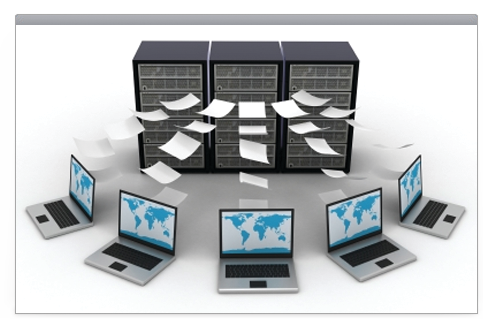Many of you have been using email for 20 years or more, but interactive collaboration tools are still somewhat new to your way of thinking and working. If you reflect on your progress in using software, you’ll find that you have become more collaborative year after year.
For example, when word processing first became available, you frequently had a typing pool to do the data entry from dictation. Then, you found it easier to look at drafts on your own machine. Later you found that some short messages and memos were easier to create yourself.
Then you probably changed your thinking to realize you could draft content at the keyboard and with the track changes feature in Microsoft Word, see the revisions others made when you sent the document to them. Now the Microsoft Word document can live in SharePoint with one or more users accessing the document from there. Competitors like Google Docs and Zoho have similar capabilities.
Now the technologies have progressed enough that when you have to be mobile, you can do much of the work you want to do. The tools are good enough to be pretty effective at email and collaboration today, with more practical tools to come.
A simple reminder is in order, though: remember that mobile devices today are still best at consuming content, not creating content. If you have a lot of heavy lifting and keying to do, you are still likely to be on a desktop, laptop or UltraBook computer. If you are simply doing a review or short responses, you may find a tablet or smartphone application sophisticated enough to get the job done.
What Can You Do Effectively?
Mobile phones made it possible to respond to email from virtually anywhere. We’ll certainly tip our hat to Rim BlackBerry for making this not only possible, but practical. As smartphones from all other vendors became easier to use, email was one of the applications that received the most attention.
Microsoft made the mobile interface to Exchange easier with ActiveSync, and smartphone vendors like Apple with iOS, Google with Android, and Microsoft themselves made email on a smartphone convenient and easy to answer. In most cases today, if you have Exchange hosted email, you can answer and file messages on a smartphone, and the message is completely handled.
You don’t have to do something more with the message when you return to the office. Most of this magic is really handled by Microsoft Exchange or by Lotus Notes email servers and very little is done on the smartphone but to provide an interface for you, the user. For some users, making the images bigger on a tablet was all it took to get off a computer and onto the couch. A simple reminder is also in order here: pick the right tool for the job. Answering a lot of email on a smartphone or tablet can be much slower than doing the job on a computer, and you’ll wind up working longer to do the same amount of work. Frequently users select the wrong tool without thinking.
Collaboration opens a whole new can of worms. Collaborative tools by their very nature can take much more interaction from the user. While touch screens have made this possible, the interfaces are often too computer-like and really require a keyboard.
We have been watching and hoping for voice technology since the late 1970’s and it is clear we are getting very close. But the style of response: type, touch, or speak, is much less important than designing the application so it allows for logical collaboration. The functions you need to perform as a user or a manager have to be presented in a logical way.
The great news for collaboration is that centralized computing is back. We call it the cloud. If you can perceive that the Internet is one big affordable mainframe with lots of powerful applications running in data centers, and you need a simple dumb terminal to connect, which we call smartphones and tablets, you have a pretty clear picture of the new collaboration model.
We can build our own private cloud for collaboration using LANs, virtualization, remote access with Remote Desktop Services, Citrix XenApp or XenDesktop or VMware View. Or, we can choose to use hosted or SaaS services from other providers. If we pick and choose, or use a hybrid model, we can select the applications that make the most sense to us and solve our client’s problems. On-premise, hosted, SaaS or Hybrid – all the models are being updated for collaboration.
What Are Some Examples of Mobile Collaboration?
Software publishers and hardware manufacturers have created products for the mobile user that enable collaboration. Most of the time these have been built with a purpose in mind, but sometimes the creation was accidental. Now that the mobile vision is pretty firmly established, vendors are creating products to meet needs that they discover and solve.
A few examples of products that are doing collaboration effectively today with documents and workflow include: AccountantsWorld CyberCabinet, Bill.com, Concur, Microsoft Office 365, ShareFile, SmartVault, XCM, and Zoho. Other products that are enabling collaborative accounting include: Accounting Relief, Aplos, Freshbooks, Intacct, Intuit QuickBooks Online, FinancialForce, Less Accounting, NetSuite, SAP Business By Design, Wave, and Xero.
You may note that all of the products cited above are Software as a Service because they are easy to mobilize, whether through a browser or with a native app on a smartphone or tablet. The publishers can be more responsive to needs because of their deployment model with centralized computers providing the computational horsepower and storage. If they see the need for a management approval, such as a payment in Bill.com or a sign-off in XCM, they can create this in their software allowing the user to do so conveniently from a mobile device.
Microsoft has notably stepped up their game with the release of Windows 8, improvements in Office 2013, Office 365, and in SkyDrive. The way that documents integrate seamlessly between local storage, cloud storage and can be edited with the same tools has made collaboration from one or more locations much more convenient.
Google has been on this same path for almost 10 years, Zoho has been building collaborative applications for 16 years and the efforts of these large publishers are starting to pay off in collaborative productivity software.
What More?
It is clear that the major software publishers are rethinking their capabilities and how do to deliver mobile solutions. We have seen new management applications from CCH, Thomson, Intuit and Sage in 2012 to enable management review and decisions on mobile devices.
Users and software engineers have not had the hardware tools to enable the mobile user for very long. The progress in three years in tablets, 10 years in smartphones and 14 years in SaaS products is remarkable.
However, the real business applications are just starting to arrive in volume and the choices in the years ahead promise to be even stronger than our choices today. Determine what would serve your mobile workers well today, and begin the process of learning how to take advantage of mobile technology.
Thanks for reading CPA Practice Advisor!
Subscribe Already registered? Log In
Need more information? Read the FAQs
Tags: Firm Management, Technology





